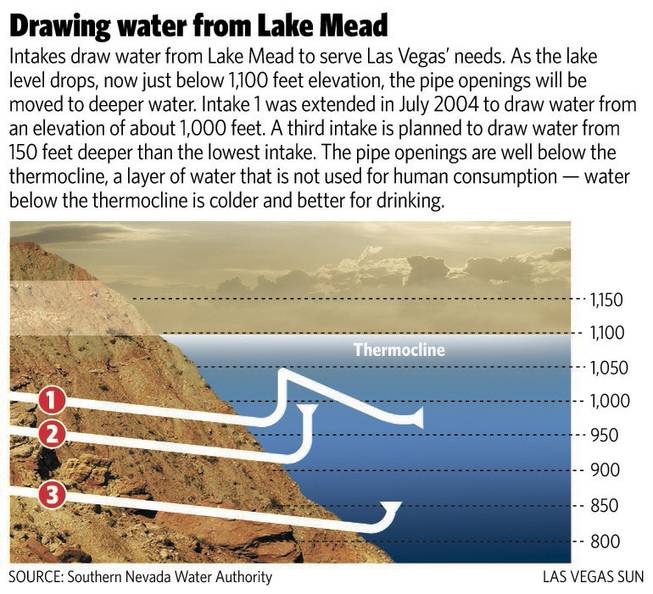Wednesday, Sept. 23, 2009 | 1:34 a.m.
Related story
The Boulder City Council held off raising water rates for the second time in a year, opting instead to stretch out its payments on the third intake into Lake Mead, put off some other projects and hope that the economy improves.
The council last fall raised water rates by 10 percent across the board and sewer rates by $9.65 to $14.65 a month per household, depending on use, beginning Oct. 1. That was expected to raise $550,000 by June 30, but brought in only $420,000, City Manager Vicki Mayes told the council.
The city also raised power rates on July 1 by three-quarters of a cent per kilowatt hour.
The extra money was supposed to go to paying the city’s share of the third intake into Lake Mead, which the Southern Nevada Water Authority is building to ensure water can be drawn from the lake as water levels decline.
A second water rate hike of 10 percent was planned to begin Oct. 1 to set aside money to pay for other infrastructure projects needed for the city’s water and sewer systems. It was expected to raise $300,000 during the fiscal year, Mayes said.
But the council balked at another utility rate increase for residents and voted 3-2 to hold off for now. Councilmen Duncan McCoy and Travis Chandler voted to go ahead with the increase.
Councilman Cam Walker and Mayor Roger Tobler asked Mayes to re-evaluate the need for the second water rate increase after Boulder City’s share of third intake came in substantially lower than originally estimated. The water authority scaled back the project, deciding not to build another pumping station until demand requires it, a move that reduced Boulder City’s expense from $26 million to $14 million, Mayes said.
“We have bought four or five years, so we can come up with other plans on this,” Tobler said. “It’s our duty as City Council members to look at why we are increasing it.”
Mayes had put together charts that showed what typical bills for Boulder City users would be compared with what they are for users in municipalities in the Las Vegas Valley.
The typical monthly bill for the lowest residential user in Boulder City would be $16.54, compared with $14.07 in Las Vegas, she said. For the lowest commercial user, Boulder City would charge $119.40 under the new rates compared with $71.06 for the Las Vegas Valley Water District. With higher usage, Boulder City’s typical bills would be substantially lower than those of the Las Vegas Valley Water District, Henderson and North Las Vegas.
But most small businesses use the smaller amounts, Walker said.
“I think it’s the wrong time, the wrong way, and it’s just not what we need to be looking at at this time in the community,” Walker said. He was particularly concerned about whether the rate increase would prompt some small businesses to move into the Las Vegas Valley to take advantage of the lower Las Vegas Valley Water District bills.
To avoid the rate increase, Mayes said, the city would have to pay its third intake bill to the water authority over 30 years instead of 20. It would also have to put off work on the water tank as well as any requests from large users to switch from potable water to raw water for irrigation or industrial use, because there is no money to build the extra pipelines.
That choice concerned McCoy.
“You’re gambling that we’re going to have a more favorable economic climate, that there will be more money available to the city,” he said. “I hope that’s true, but we don’t know that it’s true.”
Councilwoman Linda Strickland said she liked the idea of waiting for a water rate increase to give residents time to adjust to the newly imposed electric rate hike.
“If we have to come back with a water rate increase at some point, we can look at it then, but at least we can give them an adjustment period,” she said.
Chandler said that the time to increase water rates is fall, when water use naturally goes down as residents cover their pools and water lawns less frequently.
The switch to a 30-year repayment plan will mean the city will pay $880,000 this year, to match an appropriation that has already been made, $500,000 a year from 2011 through 2014, then $910,000 per year beginning in 2015, Mayes said.


Join the Discussion:
Check this out for a full explanation of our conversion to the LiveFyre commenting system and instructions on how to sign up for an account.
Full comments policy